In six-dimensional geometry, a pentellated 6-cube is a convex uniform 6-polytope with 5th order truncations of the regular 6-cube.
 6-cube |
 6-orthoplex |
 Pentellated 6-cube | |
 Pentitruncated 6-cube |
 Penticantellated 6-cube |
 Penticantitruncated 6-cube | |
 Pentiruncitruncated 6-cube |
 Pentiruncicantellated 6-cube |
 Pentiruncicantitruncated 6-cube | |
 Pentisteritruncated 6-cube |
 Pentistericantitruncated 6-cube |
 Omnitruncated 6-cube | |
| Orthogonal projections in B6 Coxeter plane | |||
|---|---|---|---|
There are unique 16 degrees of pentellations of the 6-cube with permutations of truncations, cantellations, runcinations, and sterications. The simple pentellated 6-cube is also called an expanded 6-cube, constructed by an expansion operation applied to the regular 6-cube. The highest form, the pentisteriruncicantitruncated 6-cube, is called an omnitruncated 6-cube with all of the nodes ringed. Six of them are better constructed from the 6-orthoplex given at pentellated 6-orthoplex.
Pentellated 6-cube
| Pentellated 6-cube | |
|---|---|
| Type | Uniform 6-polytope |
| Schläfli symbol | t0,5{4,3,3,3,3} |
| Coxeter-Dynkin diagram | |
| 5-faces | |
| 4-faces | |
| Cells | |
| Faces | |
| Edges | 1920 |
| Vertices | 384 |
| Vertex figure | 5-cell antiprism |
| Coxeter group | B6, [4,3,3,3,3] |
| Properties | convex |
Alternate names
- Pentellated 6-orthoplex
- Expanded 6-cube, expanded 6-orthoplex
- Small teri-hexeractihexacontitetrapeton (Acronym: stoxog) (Jonathan Bowers)[1]
Images
| Coxeter plane | B6 | B5 | B4 |
|---|---|---|---|
| Graph |  |
 |
 |
| Dihedral symmetry | [12] | [10] | [8] |
| Coxeter plane | B3 | B2 | |
| Graph |  |
 | |
| Dihedral symmetry | [6] | [4] | |
| Coxeter plane | A5 | A3 | |
| Graph |  |
 | |
| Dihedral symmetry | [6] | [4] |
Pentitruncated 6-cube
| Pentitruncated 6-cube | |
|---|---|
| Type | uniform 6-polytope |
| Schläfli symbol | t0,1,5{4,3,3,3,3} |
| Coxeter-Dynkin diagrams | |
| 5-faces | |
| 4-faces | |
| Cells | |
| Faces | |
| Edges | 8640 |
| Vertices | 1920 |
| Vertex figure | |
| Coxeter groups | B6, [4,3,3,3,3] |
| Properties | convex |
Alternate names
- Teritruncated hexeract (Acronym: tacog) (Jonathan Bowers)[2]
Images
| Coxeter plane | B6 | B5 | B4 |
|---|---|---|---|
| Graph |  |
 |
 |
| Dihedral symmetry | [12] | [10] | [8] |
| Coxeter plane | B3 | B2 | |
| Graph |  |
 | |
| Dihedral symmetry | [6] | [4] | |
| Coxeter plane | A5 | A3 | |
| Graph |  |
 | |
| Dihedral symmetry | [6] | [4] |
Penticantellated 6-cube
| Penticantellated 6-cube | |
|---|---|
| Type | uniform 6-polytope |
| Schläfli symbol | t0,2,5{4,3,3,3,3} |
| Coxeter-Dynkin diagrams | |
| 5-faces | |
| 4-faces | |
| Cells | |
| Faces | |
| Edges | 21120 |
| Vertices | 3840 |
| Vertex figure | |
| Coxeter groups | B6, [4,3,3,3,3] |
| Properties | convex |
Alternate names
- Terirhombated hexeract (Acronym: topag) (Jonathan Bowers)[3]
Images
| Coxeter plane | B6 | B5 | B4 |
|---|---|---|---|
| Graph |  |
 |
 |
| Dihedral symmetry | [12] | [10] | [8] |
| Coxeter plane | B3 | B2 | |
| Graph |  |
 | |
| Dihedral symmetry | [6] | [4] | |
| Coxeter plane | A5 | A3 | |
| Graph |  |
 | |
| Dihedral symmetry | [6] | [4] |
Penticantitruncated 6-cube
| Penticantitruncated 6-cube | |
|---|---|
| Type | uniform 6-polytope |
| Schläfli symbol | t0,1,2,5{4,3,3,3,3} |
| Coxeter-Dynkin diagrams | |
| 5-faces | |
| 4-faces | |
| Cells | |
| Faces | |
| Edges | 30720 |
| Vertices | 7680 |
| Vertex figure | |
| Coxeter groups | B6, [4,3,3,3,3] |
| Properties | convex |
Alternate names
- Terigreatorhombated hexeract (Acronym: togrix) (Jonathan Bowers)[4]
Images
| Coxeter plane | B6 | B5 | B4 |
|---|---|---|---|
| Graph |  |
 |
 |
| Dihedral symmetry | [12] | [10] | [8] |
| Coxeter plane | B3 | B2 | |
| Graph |  |
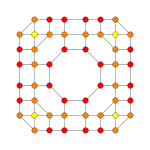 | |
| Dihedral symmetry | [6] | [4] | |
| Coxeter plane | A5 | A3 | |
| Graph |  |
 | |
| Dihedral symmetry | [6] | [4] |
Pentiruncitruncated 6-cube
| Pentiruncitruncated 6-cube | |
|---|---|
| Type | uniform 6-polytope |
| Schläfli symbol | t0,1,3,5{4,3,3,3,3} |
| Coxeter-Dynkin diagrams | |
| 5-faces | |
| 4-faces | |
| Cells | |
| Faces | |
| Edges | 151840 |
| Vertices | 11520 |
| Vertex figure | |
| Coxeter groups | B6, [4,3,3,3,3] |
| Properties | convex |
Alternate names
- Tericellirhombated hexacontitetrapeton (Acronym: tocrag) (Jonathan Bowers)[5]
Images
| Coxeter plane | B6 | B5 | B4 |
|---|---|---|---|
| Graph |  |
 |
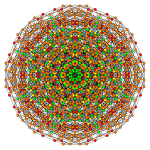 |
| Dihedral symmetry | [12] | [10] | [8] |
| Coxeter plane | B3 | B2 | |
| Graph |  |
 | |
| Dihedral symmetry | [6] | [4] | |
| Coxeter plane | A5 | A3 | |
| Graph | 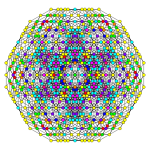 |
 | |
| Dihedral symmetry | [6] | [4] |
Pentiruncicantellated 6-cube
| Pentiruncicantellated 6-cube | |
|---|---|
| Type | uniform 6-polytope |
| Schläfli symbol | t0,2,3,5{4,3,3,3,3} |
| Coxeter-Dynkin diagrams | |
| 5-faces | |
| 4-faces | |
| Cells | |
| Faces | |
| Edges | 46080 |
| Vertices | 11520 |
| Vertex figure | |
| Coxeter groups | B6, [4,3,3,3,3] |
| Properties | convex |
Alternate names
- Teriprismatorhombi-hexeractihexacontitetrapeton (Acronym: tiprixog) (Jonathan Bowers)[6]
Images
| Coxeter plane | B6 | B5 | B4 |
|---|---|---|---|
| Graph |  |
 |
 |
| Dihedral symmetry | [12] | [10] | [8] |
| Coxeter plane | B3 | B2 | |
| Graph | 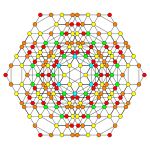 |
 | |
| Dihedral symmetry | [6] | [4] | |
| Coxeter plane | A5 | A3 | |
| Graph | 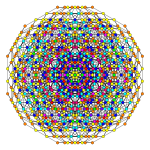 |
 | |
| Dihedral symmetry | [6] | [4] |
Pentiruncicantitruncated 6-cube
| Pentiruncicantitruncated 6-cube | |
|---|---|
| Type | uniform 6-polytope |
| Schläfli symbol | t0,1,2,3,5{4,3,3,3,3} |
| Coxeter-Dynkin diagrams | |
| 5-faces | |
| 4-faces | |
| Cells | |
| Faces | |
| Edges | 80640 |
| Vertices | 23040 |
| Vertex figure | |
| Coxeter groups | B6, [4,3,3,3,3] |
| Properties | convex |
Alternate names
- Terigreatoprismated hexeract (Acronym: tagpox) (Jonathan Bowers)[7]
Images
| Coxeter plane | B6 | B5 | B4 |
|---|---|---|---|
| Graph |  |
 |
 |
| Dihedral symmetry | [12] | [10] | [8] |
| Coxeter plane | B3 | B2 | |
| Graph |  |
 | |
| Dihedral symmetry | [6] | [4] | |
| Coxeter plane | A5 | A3 | |
| Graph |  |
 | |
| Dihedral symmetry | [6] | [4] |
Pentisteritruncated 6-cube
| Pentisteritruncated 6-cube | |
|---|---|
| Type | uniform 6-polytope |
| Schläfli symbol | t0,1,4,5{4,3,3,3,3} |
| Coxeter-Dynkin diagrams | |
| 5-faces | |
| 4-faces | |
| Cells | |
| Faces | |
| Edges | 30720 |
| Vertices | 7680 |
| Vertex figure | |
| Coxeter groups | B6, [4,3,3,3,3] |
| Properties | convex |
Alternate names
- Tericellitrunki-hexeractihexacontitetrapeton (Acronym: tactaxog) (Jonathan Bowers)[8]
Images
| Coxeter plane | B6 | B5 | B4 |
|---|---|---|---|
| Graph |  |
 |
 |
| Dihedral symmetry | [12] | [10] | [8] |
| Coxeter plane | B3 | B2 | |
| Graph |  |
 | |
| Dihedral symmetry | [6] | [4] | |
| Coxeter plane | A5 | A3 | |
| Graph |  |
 | |
| Dihedral symmetry | [6] | [4] |
Pentistericantitruncated 6-cube
| Pentistericantitruncated 6-cube | |
|---|---|
| Type | uniform 6-polytope |
| Schläfli symbol | t0,1,2,4,5{4,3,3,3,3} |
| Coxeter-Dynkin diagrams | |
| 5-faces | |
| 4-faces | |
| Cells | |
| Faces | |
| Edges | 80640 |
| Vertices | 23040 |
| Vertex figure | |
| Coxeter groups | B6, [4,3,3,3,3] |
| Properties | convex |
Alternate names
- Tericelligreatorhombated hexeract (Acronym: tocagrax) (Jonathan Bowers)[9]
Images
| Coxeter plane | B6 | B5 | B4 |
|---|---|---|---|
| Graph |  |
 |
 |
| Dihedral symmetry | [12] | [10] | [8] |
| Coxeter plane | B3 | B2 | |
| Graph |  |
 | |
| Dihedral symmetry | [6] | [4] | |
| Coxeter plane | A5 | A3 | |
| Graph |  |
 | |
| Dihedral symmetry | [6] | [4] |
Omnitruncated 6-cube
| Omnitruncated 6-cube | |
|---|---|
| Type | Uniform 6-polytope |
| Schläfli symbol | t0,1,2,3,4,5{35} |
| Coxeter-Dynkin diagrams | |
| 5-faces | 728: 12 t0,1,2,3,4{3,3,3,4} 60 {}×t0,1,2,3{3,3,4} 160 {6}×t0,1,2{3,4} 240 {8}×t0,1,2{3,3} 192 {}×t0,1,2,3{33} 64 t0,1,2,3,4{34} |
| 4-faces | 14168 |
| Cells | 72960 |
| Faces | 151680 |
| Edges | 138240 |
| Vertices | 46080 |
| Vertex figure | irregular 5-simplex |
| Coxeter group | B6, [4,3,3,3,3] |
| Properties | convex, isogonal |
The omnitruncated 6-cube has 5040 vertices, 15120 edges, 16800 faces (4200 hexagons and 1260 squares), 8400 cells, 1806 4-faces, and 126 5-faces. With 5040 vertices, it is the largest of 35 uniform 6-polytopes generated from the regular 6-cube.
Alternate names
- Pentisteriruncicantitruncated 6-cube or 6-orthoplex (omnitruncation for 6-polytopes)
- Omnitruncated hexeract
- Great teri-hexeractihexacontitetrapeton (Acronym: gotaxog) (Jonathan Bowers)[10]
Images
| Coxeter plane | B6 | B5 | B4 |
|---|---|---|---|
| Graph |  |
 |
 |
| Dihedral symmetry | [12] | [10] | [8] |
| Coxeter plane | B3 | B2 | |
| Graph |  |
 | |
| Dihedral symmetry | [6] | [4] | |
| Coxeter plane | A5 | A3 | |
| Graph |  |
 | |
| Dihedral symmetry | [6] | [4] |
Full snub 6-cube
The full snub 6-cube or omnisnub 6-cube, defined as an alternation of the omnitruncated 6-cube is not uniform, but it can be given Coxeter diagram ![]()
![]()
![]()
![]()
![]()
![]()
![]()
![]()
![]()
![]()
![]() and symmetry [4,3,3,3,3]+, and constructed from 12 snub 5-cubes, 64 snub 5-simplexes, 60 snub tesseract antiprisms, 192 snub 5-cell antiprisms, 160 3-sr{4,3} duoantiprisms, 240 4-s{3,4} duoantiprisms, and 23040 irregular 5-simplexes filling the gaps at the deleted vertices.
and symmetry [4,3,3,3,3]+, and constructed from 12 snub 5-cubes, 64 snub 5-simplexes, 60 snub tesseract antiprisms, 192 snub 5-cell antiprisms, 160 3-sr{4,3} duoantiprisms, 240 4-s{3,4} duoantiprisms, and 23040 irregular 5-simplexes filling the gaps at the deleted vertices.
Related polytopes
These polytopes are from a set of 63 uniform 6-polytopes generated from the B6 Coxeter plane, including the regular 6-cube or 6-orthoplex.
Notes
References
External links
Wikiwand in your browser!
Seamless Wikipedia browsing. On steroids.
Every time you click a link to Wikipedia, Wiktionary or Wikiquote in your browser's search results, it will show the modern Wikiwand interface.
Wikiwand extension is a five stars, simple, with minimum permission required to keep your browsing private, safe and transparent.































































